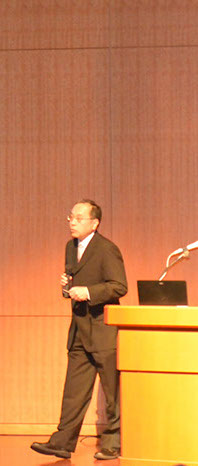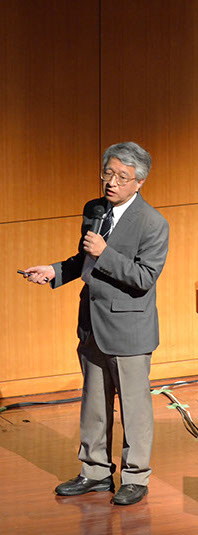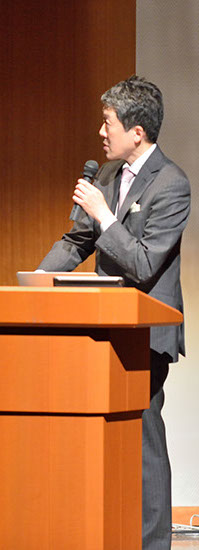
Introduction
Research and Education Environment Opened up by SINET 5: The latest information on SINET 5 to be launched in 22 months
by Jun Adachi, Deputy Director General, NII
Prof. Adachi introduced a potential model of SINET5 based on the expected information environment for research and academic communities in two years time. It is expected that cloud services and network connections will be merged to provide an advanced cyber environment on which researchers, lecturers and students can access whatever services they require.
In order to cater for such an environment, SINET5 needs to establish a super high-speed domestic network that can: 1) deal with the processing power of super computers; 2) reinforce the existing international network, so that Japan can maintain prominence in international collaborative research projects; and 3) construct a new high-speed network connecting Japan to Europe. It is also critical for SINET5 to build a safe and secure infrastructure in which users can use cloud services safely and conveniently. This will be realised by reinforcing the existing federated access management system ‘GakuNin’, issuing digital certificates, and by utilising network roaming ‘eduroam’, etc. NII’s cloud infrastructure, JAIRO Cloud, will continue to expand by providing not only varied content, but also varied repositories that cater for different research areas and media.
The key to cloud computing is security and customisation. Adachi concluded in his speech that he would like to gather users’ views and opinions via active discussion throughout the day, and reflect these opinions in the architecture of SINET5 and the future direction of NII.

Expectations from High Energy Physics to SINET5
by Toshiaki Kaneko, Professor, Director of Computing Research Center, High Energy Accelerator Research Organization (KEK)
Prof. Kaneko showed how SINET5 could serve to promote collaborative research projects from the point of view of the user whose research is heavily reliant on a high-speed network infrastructure. KEK conducts advanced scientific research and their domestic and international research projects include the CERN project (Large Hadron Collider experiments), Bell II (high-energy experiments), and ILC (International Linear Collider) project, etc. These projects produce a large volume of data which are collected, stored, processed, and analysed in laboratories, data centres and computer-cluster sites all over the world. Therefore, it is essential for researchers and institutions to have a state-of-the-art network infrastructure to support the smooth exchange of associated data. As Japan’s academic information infrastructure, SINET has been fulfilling KEK’s demands. For example, SINET has been used for the Japan Lattice Data Grid project, which connects 9 institutions throughout Japan to share simulation data on a SINET-created platform connected by L3VPN.
Kaneko hopes that SINET5 will continue to provide a stable academic information infrastructure for the Japanese academic community. For this, it is critical for Japan to have an advanced network infrastructure in terms of international competition. To do this, SINET5 should reinforce a network infrastructure, not only with the USA, but also with Europe and Asia. In a world where data are stored in a decentralised manner, one cannot separate large amounts of data, from the high-speed network and computing system; SINET5 should serve as a grid or cloud offering data storage and CPU. It is also crucial that SINET5 has advanced security measures. In recent years, cyber security has become a costly business for each institution, and it is difficult to deal with different types of cyber attacks on a site-by-site basis. In case of emergency, it is expected that various services and functions shut down simultaneously. Kaneko argued that it is not sufficient to only build a computer system to deal with such an emergency. Instead, we should also educate relevant individuals so that they become aware of security issues, such as how to treat authentication information, digital certificates and malware. Kaneko concluded his talk by saying that a network of people beyond ones’ institution will become even more important in the future for the safety and security of the network.

Expectations from a University Library to SINET5
by Hiroya Takeuchi, Professor, Director of Academic Link Centre, University Librarian, Chiba University
Prof. Takeuchi described the changes that university libraries have experienced since the 1980s, and outlined his views and hopes for SINET5 as an infrastructure to support university libraries to function as a hub for research and education.
Collaboration between information systems and libraries started with a discussion held at the Science Council of Japan and the associated subsequent report (The Future of Academic Information System; published in 1980). Since then, university libraries have become mechanised by introducing systems such as NACSIS-CAT, NACSIS-ILL and Webcat, digitalised by introducing NII-ELS and CiNii, and open by introducing institutional repositories. Ultimately, what underlines these changes is a sharing of academic information and offering this information to end users.
The changes that university libraries are currently going through can be summarised in the following five points. 1) Libraries are shifting from ‘creation of collection’ to ‘creation of collection and development of contents’; this is exemplified by institutional repositories in which teaching resources can be developed, stored and shared. 2) Libraries are shifting from ‘access to knowledge’ to ‘access to knowledge and data’; various data produced from research can be shared and used for various purposes and anyone can access these data through Discovery Services. 3) Libraries are shifting from ‘passive’ to ‘aggressive’; libraries do not simply and passively offer references anymore, but proactively provide information and support. 4) Libraries are shifting to manage what is unique in their collection; in the age of digitalisation, resources that are only available at specific individual libraries become even more important and so should be made accessible by utilising the network. 5) Libraries are expected to nurture professionals who can change the teaching environment by managing data and creating content.
Takeuchi argued that these changes cannot be achieved by a single library or institution: it is the role of SINET5 to support university libraries to go through these changes. For university libraries, SINET5 will not simply be a network or cloud. Takeuchi concluded that he hopes SINET5 will provide a system in which contents are distributed and made accessible to end users via integrated Discovery Services.


